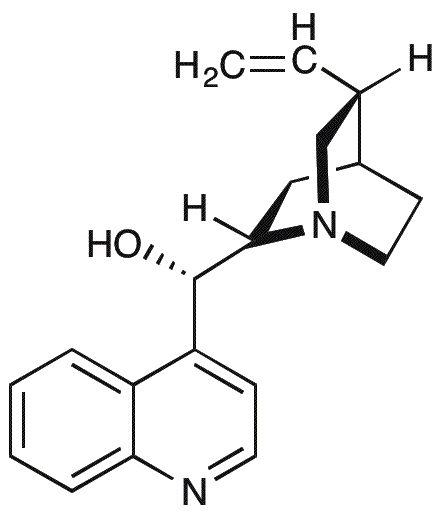Cinchonine is widely utilized in research focused on:
- Pharmaceutical Development: Cinchonine is a key compound in the synthesis of various pharmaceutical agents, particularly in the development of antimalarial drugs. Its ability to inhibit the growth of malaria parasites makes it invaluable in tropical medicine.
- Analytical Chemistry: This compound serves as a chiral auxiliary in asymmetric synthesis, helping chemists create enantiomerically pure compounds. Its effectiveness in improving yields and selectivity is crucial for the production of pharmaceuticals and agrochemicals.
- Natural Product Research: Cinchonine is often studied for its potential health benefits, including its role in traditional medicine. Researchers explore its effects on various biological pathways, which may lead to new therapeutic applications.
- Food and Beverage Industry: The compound is used as a flavoring agent in certain beverages, providing a unique taste profile. Its natural origin appeals to consumers seeking authentic and traditional flavors.
- Biochemical Research: Cinchonine is utilized in studies investigating its interaction with various biological molecules, contributing to our understanding of enzyme mechanisms and receptor binding, which is essential for drug design.
Información general
Propiedades
Seguridad y normativas
Aplicaciones
Cinchonine is widely utilized in research focused on:
- Pharmaceutical Development: Cinchonine is a key compound in the synthesis of various pharmaceutical agents, particularly in the development of antimalarial drugs. Its ability to inhibit the growth of malaria parasites makes it invaluable in tropical medicine.
- Analytical Chemistry: This compound serves as a chiral auxiliary in asymmetric synthesis, helping chemists create enantiomerically pure compounds. Its effectiveness in improving yields and selectivity is crucial for the production of pharmaceuticals and agrochemicals.
- Natural Product Research: Cinchonine is often studied for its potential health benefits, including its role in traditional medicine. Researchers explore its effects on various biological pathways, which may lead to new therapeutic applications.
- Food and Beverage Industry: The compound is used as a flavoring agent in certain beverages, providing a unique taste profile. Its natural origin appeals to consumers seeking authentic and traditional flavors.
- Biochemical Research: Cinchonine is utilized in studies investigating its interaction with various biological molecules, contributing to our understanding of enzyme mechanisms and receptor binding, which is essential for drug design.
Documentos
Hojas de datos de seguridad (HDS)
La SDS proporciona información de seguridad completa sobre la manipulación, el almacenamiento y la eliminación del producto.
Especificación del producto (PS)
La PS proporciona un desglose completo de las propiedades del producto, incluida la composición química, el estado físico, la pureza y los requisitos de almacenamiento. También detalla los rangos de calidad aceptables y las aplicaciones previstas del producto.
Certificados de análisis (COA)
Busque certificados de análisis (COA) ingresando el número de lote del producto. Los números de lote y de partida se pueden encontrar en la etiqueta de un producto después de las palabras "Lote" o "Lote".
Número de catálogo
Número de lote/lote
Certificados de origen (COO)
Este certificado de origen confirma el país en el que se fabricó el producto y también detalla los materiales y componentes utilizados en él y si se deriva de fuentes naturales, sintéticas u otras fuentes específicas. Este certificado puede ser necesario para cumplir con las normativas aduaneras, comerciales y regulatorias.
Número de catálogo
Número de lote/lote
Hojas de datos de seguridad (HDS)
La SDS proporciona información de seguridad completa sobre la manipulación, el almacenamiento y la eliminación del producto.
DownloadEspecificación del producto (PS)
La PS proporciona un desglose completo de las propiedades del producto, incluida la composición química, el estado físico, la pureza y los requisitos de almacenamiento. También detalla los rangos de calidad aceptables y las aplicaciones previstas del producto.
DownloadCertificados de análisis (COA)
Busque certificados de análisis (COA) ingresando el número de lote del producto. Los números de lote y de partida se pueden encontrar en la etiqueta de un producto después de las palabras "Lote" o "Lote".
Número de catálogo
Número de lote/lote
Certificados de origen (COO)
Este certificado de origen confirma el país en el que se fabricó el producto y también detalla los materiales y componentes utilizados en él y si se deriva de fuentes naturales, sintéticas u otras fuentes específicas. Este certificado puede ser necesario para cumplir con las normativas aduaneras, comerciales y regulatorias.


